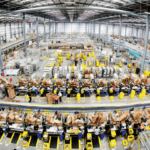The sheer speed and convenience of Amazon UK’s delivery and collections service enables it to compete with large multichannel retailers despite having no shops of its own in the UK
Amazon is working to an agenda set by the ever-more demanding customer, Katie McQuaid, director of Fufilment by Amazon, told the audience at eDelivery Conference this October. “We all know customer expectations continue to charge ahead in terms of how fast they want to get it,” she said. “They want it to as close to popping into the store that’s right by them as possible. We’re continuing to invest in that and Amazon Prime for us is the way we choose to do that, the vehicle that allows us to do that.”
The pureplay makes its logistics work, despite having no physical store estate of its own in the UK, through an extensive network of local hubs and distribution centres. Its 12 UK fulfilment centres and 28 delivery stations enable it to offer a wide choice of delivery options that rival that next-to-the-store experience. Those centres collectively employ 12,000 permanent staff, of whom 3,500 joined in 2016 alone.
Amazon deliveries start from a standard service that delivers within one to two days of dispatch and is free for orders of more than £10 or £20, depending on the type of product ordered. At the other end of the range, Prime members living in areas including London and Birmingham can enjoy one-hour delivery. Also available are same-day and same-evening collection from a range of Amazon Pickup points, which include its own lockers and stores in the PassmyParcel network, as well as Doddle parcel shops and branches of the Post Office . Prime membership is key to accessing the fastest services – members can order for a million products for free same-day delivery, or choose from a range of 15,000 products for one-hour delivery. The Prime scheme, which has effectively replaced Amazon’s one-time universal free standard delivery offer, has saved its UK members a collective £1bn in delivery charges that they would otherwise have paid, claims McQuaid.
Amazon has developed its own Amazon Logistics platform in order to fulfil its most ambitious delivery promises. Through this platform, it works with local delivery operators to ensure that each parcel gets to its recipient.
Importantly, the focus is no longer on selling the products that it stocks. Some 50% of global sales on Amazon’s platform are now made by the third-party sellers who use its marketplace, and it’s the fast growth of fulfilling marketplace orders on behalf of others, through the Fulfilment by Amazon programme, that is driving the fast expansion of its UK distribution network.
This, says McQuaid, has seen investment of £4.6bn since 2010. UK sellers’ orders can now be fulfilled through its European warehouses, enabling fast delivery across Europe. McQuaid says that last year, UK retailers exported products worth £1.4bn via the Amazon platform.
The next step will be the world, with US sellers able to have their European orders fulfilled by Amazon, as will UK sellers targeting the US, and Chinese sellers looking to sell their products internationally. Enabling this last group to store their product closer to customers in markets such as Europe will help them deliver on customer expectations, says McQuaid: “Fulfilment by Amazon allows us to hold stock across the globe for the fast delivery that customers require. We’re able to provide the service not only for customers but also for the retailers that rely on us.”
Always innovative, Amazon UK has already this year launched its grocery delivery service, AmazonFresh, which offers competitive one-hour delivery slots between 7am and 11pm, seven days a week. Announcing in September that the service’s postcode coverage had doubled to 190 Greater London postcodes, Amazon promised that customers ordering their groceries at lunchtime could have them delivered in time for dinner. Ajay Kavan, vice president of AmazonFresh, said at the time that “convenient delivery options” were one of the main attractions of the service, along with the wide range of groceries available for delivery.
As it looks to move towards 30-minute deliveries, this year also saw the retailer launch AmazonFlex, in which car drivers can deliver Amazon parcels in their spare time. Looking to the longer term, it is also testing drones in trials with the UK Civil Aviation Authority and hopes to use them to deliver parcels weighing up to 2.3kg in as little as half an hour.
Amazon’s returns and refunds policy is also competitive. Customers can return most products within 30 days of receiving them, as long as they are unused and complete. It will refund the costs of outbound delivery if an item is defective or the order is cancelled, and it will refund the cost of sending back a damaged or defective item, but will only refund the cost of sending back some cancelled orders. Food items ordered through the Amazon Fresh service generally can’t be returned but may be refunded where damaged.







